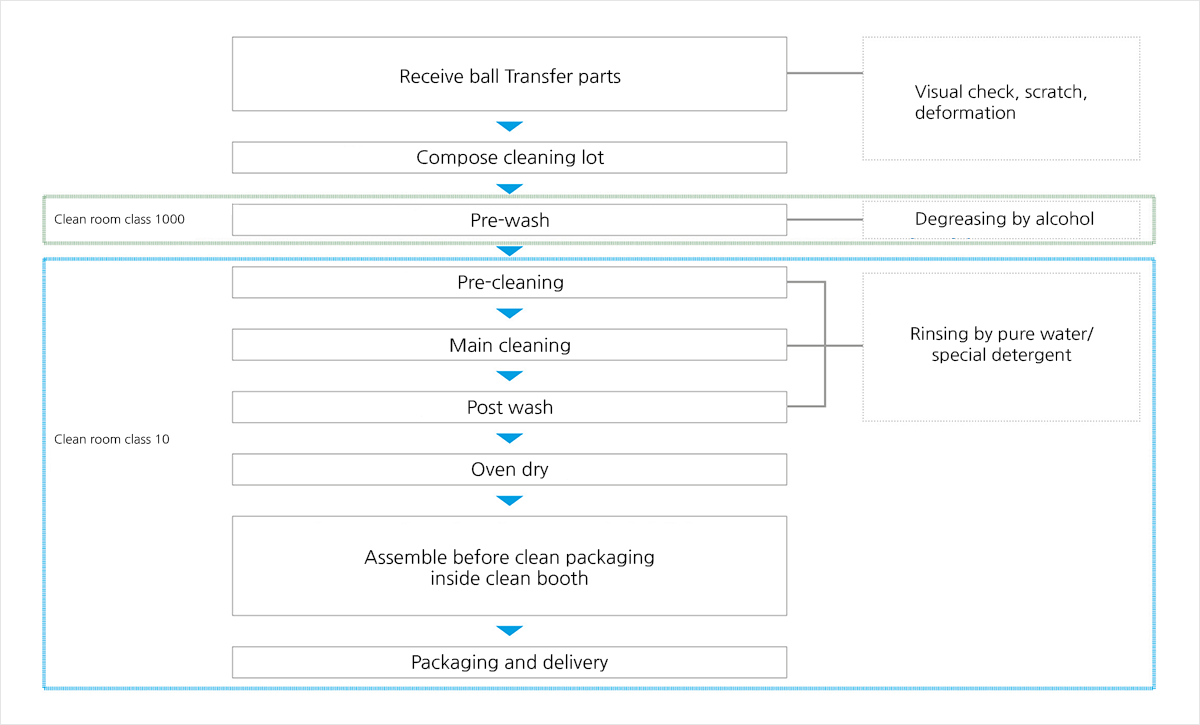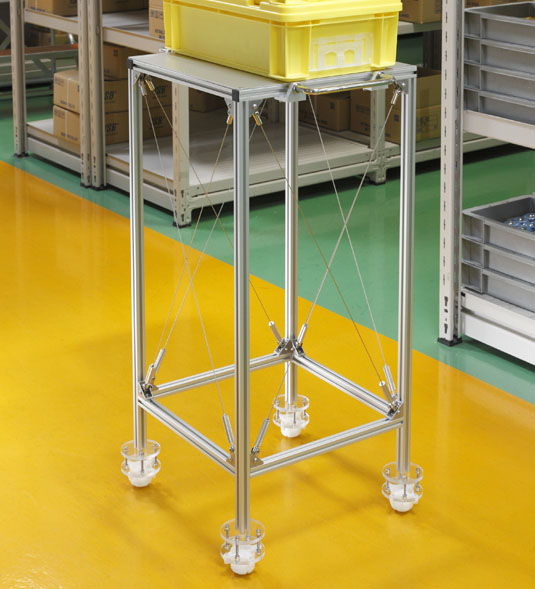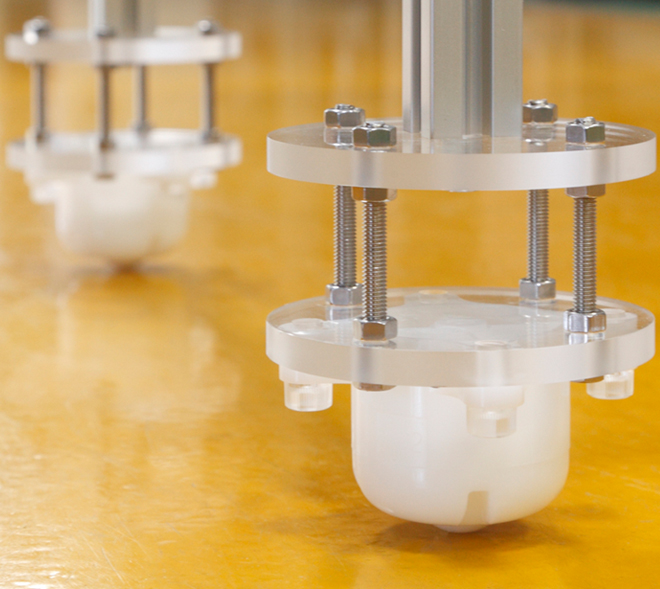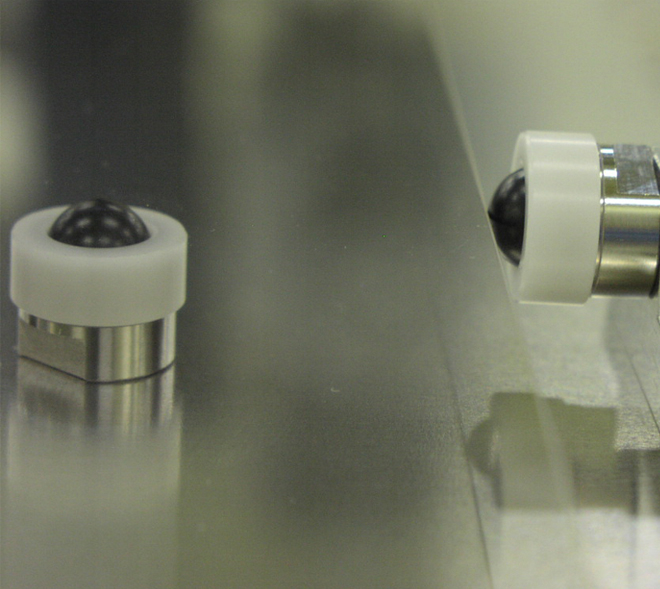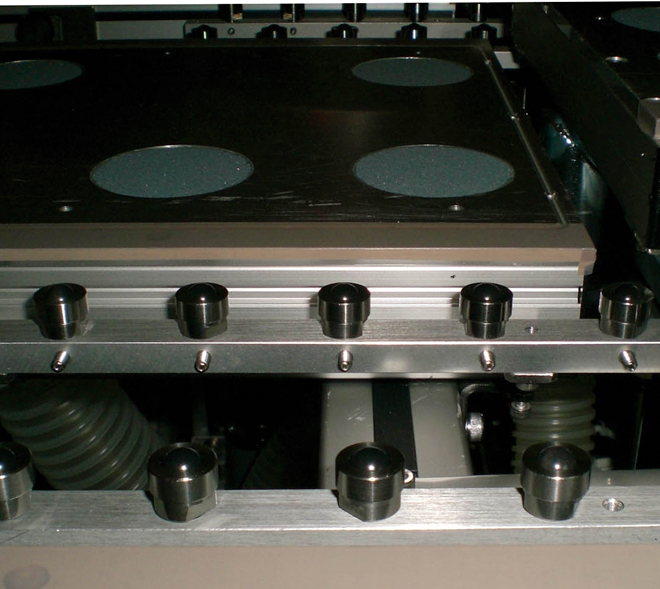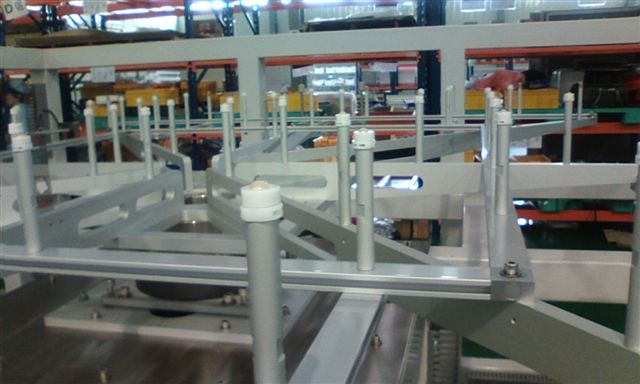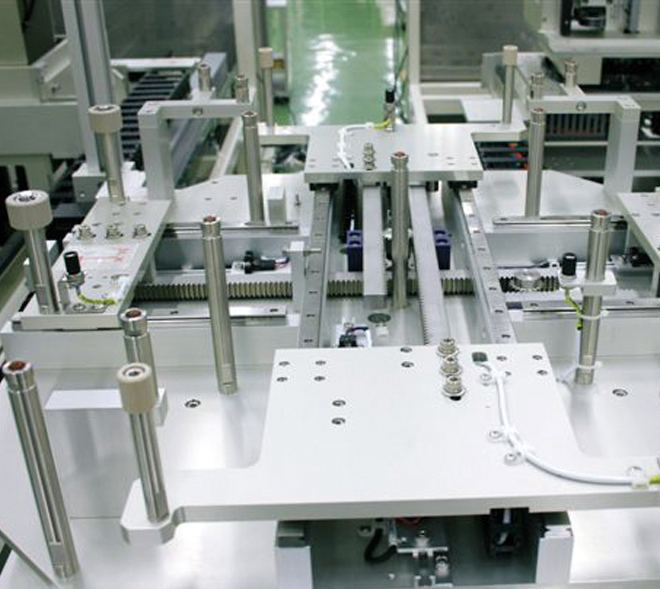Features of Cleanroom Ball Transfers
- Scratch-free DuPont Vespel® and variety of other engineering plastics such as PBI and PEEK for handling glass substrates.
- Our original and unique clean-technology enables to suppress particle generation to the highest cleanness.
- We developed a new range of low-cost molded ball transfers in addition to high precision machine-cut ball transfers.
- Varity of degreasing cleaning packages are available upon request for specific environments and clean rooms. For more detail please contact us.
- A wide range of products with variety of materials are available for specific applications such as wet, dry processes, mother glass trimming, cutting, optical measuring apparatus where minimum light reflection is desired, vacuum chambers and high temp over 200℃, etc.
- Customized ball transfers for specific applications are also available upon request.
*The DuPont™, and DuPont Vespel® are registered trademarks of E. I. du Pont de Nemours and Company or its affiliates.
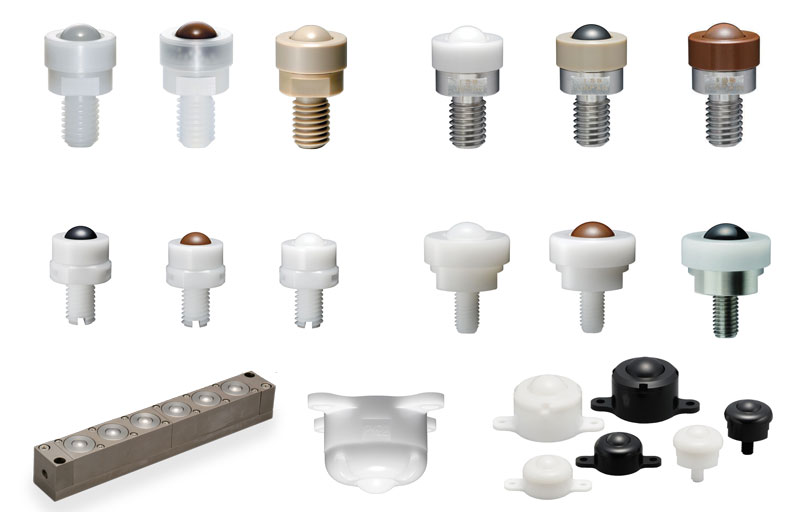
Advantages of Cleanroom Ball Transfers
- Friction resistance 1/10 compare to conventional Pin alignment.
- Ball transfer alignment and positioning enables, less friction, long life, stability, compare to Pin which wear soon.
- With low friction reduce lines, cracks and flaws on glass substrate; improve yields at loader/unloader and other applications.
- Frequent replacement is not needed which occurs from abrasion or wear.
About Cleanroom Ball Transfer load capacity
The load capacity on each ball transfer used inside a clean room differs depending on the application specification. We highly recommend consulting with our sales staff in order to select the right material for your application. Also please keep in mind following points:
- Device characteristics and operating environment
- Materials in contact (Ball vs. Floor, Wall, Etc.)
- Travel distance
- Travel speed
From our long experience with a wide range of products specified in a variety of applications from FPD to PV and other clean room applications, we recommend when using clean room ball transfers in an application, consider 0-1kg on each ball transfer.
Although in some cases above information may not be applicable in that case please contacts us for a better solution.
Electrically Conductive ISC Series Ball Transfer
This unique electrically conductive ISC ball transfers are used in FPD production lines especially at pre-processing. To meet our customers special requirements the material of ball transfer can be customized according to application.
Anti-static Property Test of Electrically Conductive ISC Series Ball Transfers
The anti-static properties of the electrically conductive ISC Series ball transfers were tested by the following method.
When the surface of LCD glass substrate is charged with electrostatics, we attached an ESD and a normal ball transfer to glass substrate and measured the static voltage reduction for both products.
B1 ESD ball transfer
(Electrically conductive ball transfer Main ball surface electric resistance factor: 10^4 to 10^5)
B2 Normal ball transfer
(Non-electrically conductive ball transfer Main ball surface electric resistance factor: 10^12 or greater)
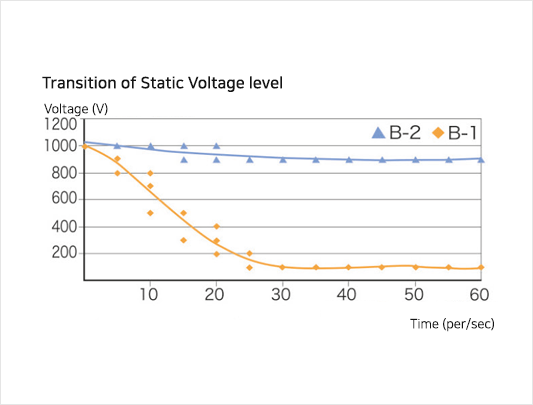
Clean Room Ball Transfers basic performance
Using clean room ball transfers in an application depends on applications specifications, article, load, class of clean room as well as the environment.
Choosing a combination of materials is a critical key when selecting a ball transfer for a specific application. Since the design and concept of conventional ball transfers are no longer applicable, we tested the new ball transfers in our in-house test room to obtain preliminary approximate data, assuming that application is limited to glass substrate alignment in semiconductor/FPD production lines.
Note: Use utmost care when evaluating the data below, they were obtained under limited conditions. For more information and details, contact our sales department.
Dust generation comparison test between Ball transfer and PEEK Pin
How we conducted the test: In a clean room booth, FPD glass substrate was supported by ISC Ball Transfer Transfers or PEEK Pins, then we moved the glass substrate a few millimeters while an estimated weight was given. Generated particles were collected in water and counted by a particle counter.
Note: The number of particle accuracy is not guaranteed
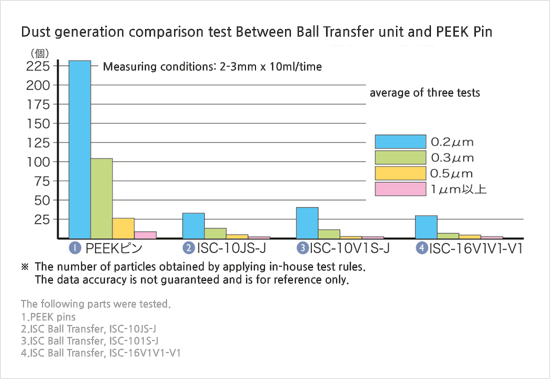
Friction Comparison Test of Ball Transfer vs. PEEK Pin
Test conditions: In a general environment, the glass substrate was supported by six ISC ball transfers and PEEK pins, moved few times with a fixed force in a horizontal direction then measured by a loadcell device.
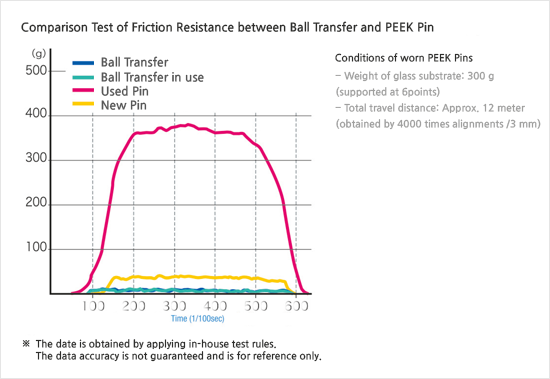
Measurement of ball transfer friction coefficient
Research objective: to measure friction coefficient of ISCS-10P1S-J
Survey content: measured each ball transfer friction coefficient under 100gf, 500gf, 1000gf.
Traveling speed: about 5mm/min
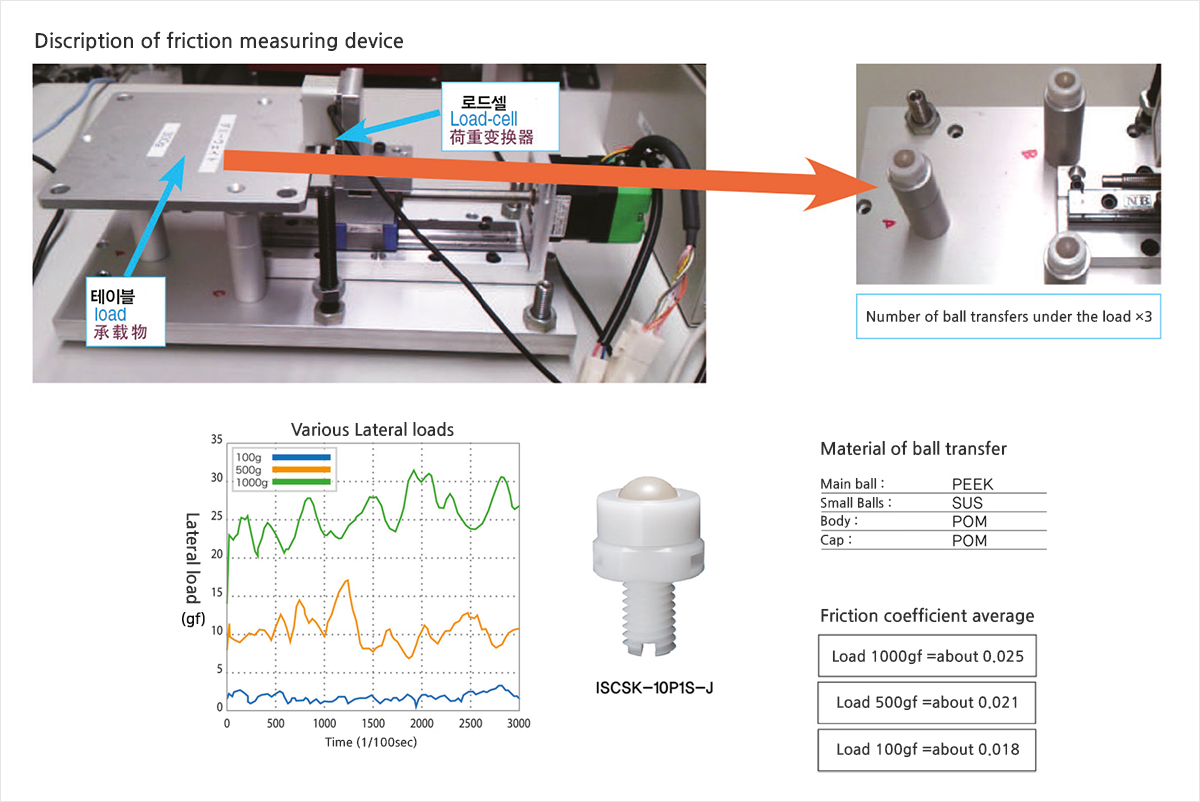
Quick Reference Chart

1. Main ball size (Diameter in mm)
2. Main ball material
3. Small Balls material
4. Body material
5. Cap material (No referance if material is same as body)

1. Main ball size (Diameter in mm)
2. Main ball material
3. Small Balls material
4. Body material

1. Main ball size (diameter in mm)
2. Main Ball material
What is W/NW/B/NB ?
W : POM (White) Flange
NW : POM (White) Bolt type
B : POM (Black) Flange
NB : POM (Black) Bolt type
Material
V1 : Vespel® SP
V2 : ESD Vespel® SP
V4 : Vespel® CR
V5 : Vespel® TP
V8 : ESD Vespel® TP
Z1 : PBI
Z2 : ESD PBI
Z3 : PBI
P1 : PEEK
P2 : ESD PEEK
U1 : UHMWPE
U2 : ESD UHMWPE
F : 3F
J : POM
S : SUS304
C : Ceramic
Degreasing Cleaning Process
ISB Cleaning 1
Cleaning (With Thinner)
Post-cleaning assemble with gloves.
Packed and sealed individually after dried.
ISB Cleaning 2
Ultrasonic cleaning (with absolute ethanol)
After cleaning assembled with gloves to avoid contamination. Packed and sealed individually, after completely dried-up.

